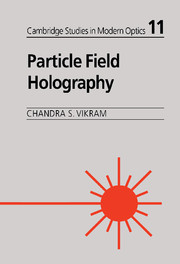Book contents
- Frontmatter
- Contents
- Foreword
- Preface
- Acknowledgements
- 1 Historical background
- 2 Introduction to holography
- 3 General theory of in-line Fraunhofer holography
- 4 System design considerations
- 5 Practical considerations
- 6 Analysis of reconstruction
- 7 Aberrations and their control
- 8 Hologram fringe-contrast and its enhancement
- 9 Non-image plane analysis
- 10 Velocimetry and high speed holography
- 11 The off-axis approach
- References
- Index
10 - Velocimetry and high speed holography
Published online by Cambridge University Press: 13 October 2009
- Frontmatter
- Contents
- Foreword
- Preface
- Acknowledgements
- 1 Historical background
- 2 Introduction to holography
- 3 General theory of in-line Fraunhofer holography
- 4 System design considerations
- 5 Practical considerations
- 6 Analysis of reconstruction
- 7 Aberrations and their control
- 8 Hologram fringe-contrast and its enhancement
- 9 Non-image plane analysis
- 10 Velocimetry and high speed holography
- 11 The off-axis approach
- References
- Index
Summary
Two or more recordings of moving microobjects can be recorded to the same recording medium. The different sets of images provide the displacement and other changes (such as shape and change in size of burning coal particles). Non-image plane analysis techniques (see Chapter 9) have also been applied for velocimetry applications. Different reference or object beam directions for storing different frames provide another way of multiplexing. The techniques of high speed photography have also been extended to holographic applications. In this chapter we will discuss the methods applicable to particle field holography.
Multiple-exposure holography
The object–image point relationships (see Chapter 6) are known. The concepts of high speed photography can be used there to extract the velocity and other time variant changes with the object field. The advantage of using holography is that microobjects in a volume with changes in three dimensions can be studied. As reported by Boettner and Thompson, a microobject can be allowed to move during the exposure to obtain a streak yielding the path of the movement. Trolinger and coworkers introduced the use of multiple exposures to study the dynamics of the particle field. Multiple exposures can be provided, for example by several lasers with synchronized fires, or more conveniently by active or passive Q-switches. Trolinger, Belz and Farmer reported several double exposure holograms and reconstructions demonstrating the usefulness of the technique in velocity and other transient phenomena studies. A double-exposure hologram of the moving particle field reconstructs two sets of images.
- Type
- Chapter
- Information
- Particle Field Holography , pp. 209 - 222Publisher: Cambridge University PressPrint publication year: 1992



